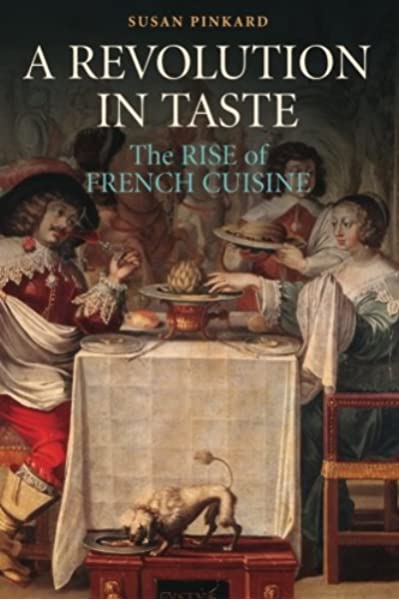In an age of the Food Network, Gourmet magazine, and Bon Appétit podcasts, it is likely that you have heard someone discussing the importance of fresh and local ingredients. Many cookbooks published in past ten years promise simple and efficient ways to cook healthy meals. This all seems like a recent fad, but in fact concerns about local ingredients and simple cooking methods began centuries ago.

Susan Pinkard's A Revolution in Taste: The Rise of French Cuisine, 1650–1800 is a description of the shift from French medieval to modern cuisine. In France, ideas about the quality of ingredients, healthy diets, and simple cooking methods changed dramatically from 1650–1800. Pinkard's story, however, is as much about society, culture, philosophy, and science as it is about cuisine. The changes occurring in French food were intimately connected with the radical shifts in French thought during the same time period. A historian at Georgetown University, Pinkard describes a revolution in the way food was conceived and produced over the course of seven chapters divided into three sections and a lengthy appendix of recipes.
Pinkard begins with two chapters about Ancient, medieval, and Renaissance cooking and dietary practices. These chapters are not Pinkard's main research focus; she merely mentions some of the primary sources available for studying the history of food in this period. Pinkard's summary of early French cuisine is lucid and engaging. She has also provided helpful charts simplifying Hippocratic medical theory and dietetics, which plays a major role in early culinary practices.
The next two sections of the book get us to the main courset: the radical shift from medieval and Renaissance cooking to modern cuisine (cuisine bourgeoise and nouvelle cuisine). Pinkard describes many changes which take place from the seventeenth century to the late eighteenth century, but two major themes are prominent throughout her work. First, a trend toward simplicity initiated in the early seventeenth century. Natural and simply prepared foods (le goût naturel) became more popular as French philosophies embracing naturalness propagated by Denis Diderot, Chevalier Louis de Jaucourt, and Jean-Jacques Rousseau also grew in popularity. The idea of a natural and moderate diet also became acceptable through the work of physicians such as George Cheyne. As a result, locally-grown, in-season vegetables gradually became fashionable at upper-class dining tables. As a result, fewer spices were used in the seventeenth and eighteenth centuries than in the Middle Ages and Renaissance, leaving pepper as one of the only spices frequently used in French cooking.
Second, French cuisine also became more artistic, delicate, and systematic. The rise of these characteristics ultimately meant that French cuisine was accessible to more people. Artistic and refined foods may have begun in upper-class households, but became more attainable for a rising middle class as restaurants developed in the eighteenth century and cookbooks became less expensive and readily available. Systematic cooking methods were carefully described in cookbooks of the period, allowing more people, including bourgeois household cooks, to create masterful dishes and sauces.
Pinkard draws her evidence of these changes from seventeenth and eighteenth century French cookbooks and the works of French philosophers and scientists from the same period. She utilizes four cookbooks throughout much of her monograph: François Pierre la Varenne's Le Cuisinier françois (1651), Nicolas de Bonnefons's Les Délices de la campagne (1654), François Massialot's Le Cuisinier roïal et bourgeois (c. 1690), and François Menon's La Cuisinière bourgeoise (1746). Pinkard's descriptions of these cookbooks interwoven throughout each chapter are riveting. Each cookbook and author had a distinct personality, and these books can be found at the center of philosophical debates about food in the Enlightenment. These books combine descriptions of food and ingredients with innovative organizational and indexing systems, such as grouping recipes by main ingredient. These books were important not only for providing recipes for delicious foods, but their adaptability to the middle-class kitchen, suggesting substitute ingredients and methods easier for a lone cook in the kitchen to master.
Pinkard's final chapter is devoted to changes in beverages from the Middle Ages to 1800. Like the first two chapters, it is based upon secondary literature. The chapter is an interesting counterpoint to the rest of the book; many of the same changes were occurring in beverages as in cuisine. Wine especially underwent a major transformation, due in part to changes in bottling methods, aging, and a desire for wines with regional distinctions, and the introduction of strong colonial drinks such as brandy, coffee, and chocolate into the French diet. As wines changed, so too did rules about integrating wines into meals and pairing with food.
Despite being such an interesting account of food up to 1789, A Revolution in Taste remains somewhat unsatisfying in one regard. Pinkard does not actually address culinary changes during the French Revolution itself. Instead, Pinkard tiptoes into the 1770s in Chapter Six and later describes changes in cuisine in the nineteenth century in the Epilogue. I was left wanting a second helping (or at least a chapter devoted to food in the 1780s and 1790s). My desire for more was only partly fulfilled by Pinkard's mouthwatering modern adaptations of thirty-five early modern French recipes. The inclusion of these recipes instantly makes this otherwise strictly academic monograph into a must-read for anyone interested in cooking French food.
That said, Susan Pinkard has crafted an engaging narrative of change and revolution in France, not only in food, but also in social, cultural, philosophical, and scientific matters, and her description of early modern French cuisine reminds us that our modern ideas about food are not so new after all.
